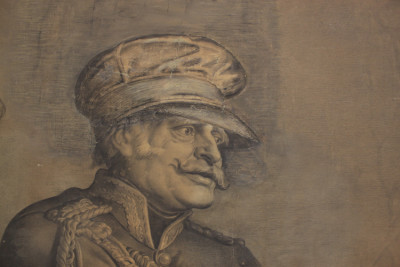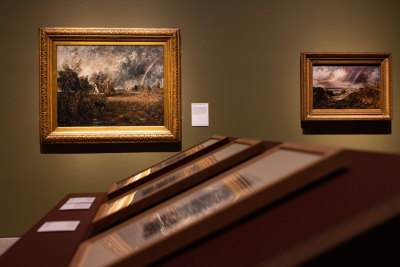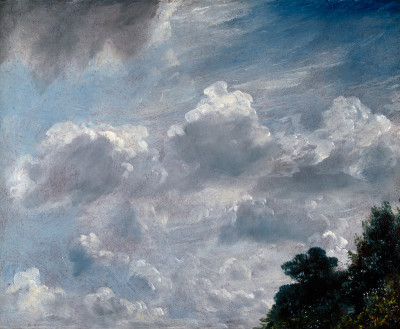Restoring a masterpiece
Restoring a masterpiece
The 'Waterloo' cartoon
By Annette Wickham
Published 24 March 2014
Thanks to a grant from Arts Council England, Daniel Maclise’s monumental ‘Waterloo’ cartoon is to undergo conservation treatment in time for the 200th anniversary of the Battle of Waterloo in 2015.
-
Some exciting news from the RA Collection, as a unique but largely forgotten work of art is being brought to light. Thanks to a generous grant from Arts Council England, Daniel Maclise’s Waterloo cartoon is to undergo conservation treatment in time for the 200th anniversary of the Battle of Waterloo in 2015. The size, condition, and subject matter of this monumental drawing have conspired to keep it under wraps for a very long time, and we’re delighted to be making it accessible online and in future displays. We’ll be documenting this process online as well so be sure to watch this space.
I first saw Maclise’s Waterloo cartoon in a store room in East London nearly two years ago, and I was hugely impressed. The drawing has been hidden away in storage for decades so this was a rare opportunity. Doing my homework beforehand, I read up on the reviews it received back in 1859 when it was first put on display. At that time, critics hailed the cartoon as ‘magnificent’, ‘a marvel in art’ and ‘the greatest work of its class that has been produced in England’. I thought this was all just Victorian hyperbole but I was surprised to find that the cartoon still packs a very powerful visual punch.
Apart from any other considerations, I had never seen a drawing this big before. It is genuinely monumental in scale, measuring nearly 12 metres in width and over 3 metres in height. Maclise wanted to work on this huge composition in his own home so he had the paper fixed to 10 panels and worked on each one separately before joining them together again once he had finished. It’s a challenge to find a space large enough to even view a work of this size let alone to display it and when I saw the drawing, the ten panels were simply propped up side by side around the walls of a store room for a group of conservators and curators to examine. Even displayed in this makeshift way, and with parts of the drawing in poor condition, the cartoon still had great presence.
-
This is the greatest work of its class that has been produced in England: nor is there any painter of the Continent who has surpassed it.
The Art Journal
-
One of the remarkable things about seeing this drawing up close is the sheer amount of detail that covers nearly every inch of the paper. This level of ‘finish’ can sometimes be deadening in a drawing but here it makes the image more intense. Maclise spent just over a year on this painstaking drawing because it was to serve as a ‘cartoon’, or full-scale design, for a fresco he was about to paint in the Houses of Parliament. This was a high profile commission and, as the battle of Waterloo was still in living memory, Maclise went to great efforts to make sure that all the uniforms and historical details were as accurate as possible. Given that he was depicting a famous British victory, though, I was surprised to see how much the artist focused on the grim reality and human cost of warfare: on either side of the composition lie sprawling heaps of dead, dying and wounded soldiers from both sides of the conflict. These figures are life-size and drawn so skilfully and with such clarity that the effect is particularly vivid.
The size, condition, and subject matter of this drawing have conspired to keep it under wraps for a very long time. I am delighted that, thanks to a generous grant from Arts Council England, this unique but largely forgotten work will now be brought to light in time for the 200th anniversary of the Battle of Waterloo in 2015. Conservation treatment will take place this summer and is key to opening up the story of this extraordinary drawing, making it accessible online and in future displays, and putting it in context with other depictions of this iconic ‘final battle’.
Watch this space for updates on the conservation process and more details of plans for the 2015 Waterloo anniversary.
Annette Wickham is the RA’s Curator of Works on Paper.
Cartoon for The Meeting of Wellington and Blücher After the Battle of Waterloo, March 1858–June 1859. All images © Royal Academy of Arts, London
-

Daniel Maclise, 'Waterloo' cartoon

Daniel Maclise, 'Waterloo' cartoon

Daniel Maclise, 'Waterloo' cartoon

Daniel Maclise, 'Waterloo' cartoon

Daniel Maclise, 'Waterloo' cartoon

Daniel Maclise, 'Waterloo' cartoon
-
About the RA Collection
Click here to find out more about the RA Collection and Library. If you would like to come and visit, we are open from Tuesdays to Fridays. Please book an appointment first by calling 020 7300 5737 or emailing library@royalacademy.org.uk









